Arctic Grayling
by Clive Schaupmeyer
I have great memories of fly-fishing for arctic grayling in pristine rapids in the Northwest Territories. Grayling are colorful salmonids that readily take dry flies and nymphs, and the action can be unbelievable!
Arctic grayling, Thymallus arcticus, is the only species of grayling in North America.  They also live in the western part of Russia and are closely related
to the European grayling. They are members of the trout and salmon (Salmonidae) family and have the essential fleshy adipose fin on the back near the tail. Grayling have an outstanding sail-like dorsal fin that is long, tall and flecked with shades of sky
blue and red or pink. The fin on an adult male is about one quarter of the entire body length and is about as tall as the body is deep. They also live in the western part of Russia and are closely related
to the European grayling. They are members of the trout and salmon (Salmonidae) family and have the essential fleshy adipose fin on the back near the tail. Grayling have an outstanding sail-like dorsal fin that is long, tall and flecked with shades of sky
blue and red or pink. The fin on an adult male is about one quarter of the entire body length and is about as tall as the body is deep.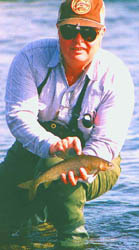
In North America, grayling are common in Alaska, Yukon, the Northwest Territories, northern parts of British Columbia, Alberta, Saskatchewan and as far east as Manitoba. There are small populations in Montana, Utah and Wyoming.
If you have the opportunity to travel to northern regions that have high populations of arctic grayling, you are in for some real fun. Where I've fished in the Northwest Territories it's not a matter of whether or not you'll catch
grayling, but how many. If they are in the water in front of you, you will catch them - one after another.
My brother and I made trips to the Northwest Territories in 1992 and 1993 to fish for grayling and lake trout. To get there we flew by commercial airline due north from Edmonton to Yellowknife. From there we took the hour-long flig
ht in a Twin Otter northeast to Mackay Lake. The lodge there caters to anglers during July and part of August and caribou hunters through September. Most anglers come up for the lake trout, but trips are worth it just for the grayling.
The lay of the moss-covered and rocky land, countless lakes and networks of connecting streams and waterways are quite different from southern waters. The geography north of Yellowknife is a combination of rock, shrubs, moss and wa
ter - perhaps 30 percent of the area is covered with water. Smaller flowing "lakes" become narrow, widen again and narrow into rivers before finally entering into the main part of larger lakes.
All of this widening and narrowing - at least where we were - creates many ideal grayling-holding waters since they prefer to hold in fast, oxygenated water. Grayling hold where water exits a lake, in narrows between lakes and in f
aster water as it enters a lake. Up north it is not always clear - and not important anyway - whether you are actually fishing a river or just a fast part of a narrow lake.
One of the big thrills on my two grayling fishing trips were the caribou.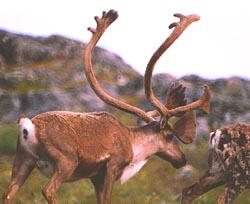 We visited the same lodge during the same week in two consecutive years. And the barren-grou
nd caribou arrived in the middle of both weeks on the southward-bound leg of their annual migration. It was possible to wade in rough-and-tumble narrows, catch dozens of scrappy grayling and watch hundreds of caribou walk through shallows or swim deeper p
arts of the narrows - sometimes mere yards away. We visited the same lodge during the same week in two consecutive years. And the barren-grou
nd caribou arrived in the middle of both weeks on the southward-bound leg of their annual migration. It was possible to wade in rough-and-tumble narrows, catch dozens of scrappy grayling and watch hundreds of caribou walk through shallows or swim deeper p
arts of the narrows - sometimes mere yards away.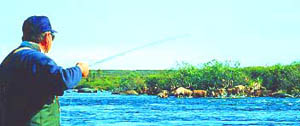 
Arctic grayling are easy to catch, but on our two trips we had to use different flies each year. We caught them on dry flies one year and nymphs the next. On the first trip they came up to Elk Hair Caddis flies and other bushy dry
flies like Humpies. It didn't matter that they were not rising and that there were no surface insects. Clearly, these fish have to be opportunistic to survive in such a harsh climate with short summers and they aggressively came up to the dry flies antici
pating a snack. These grayling are rarely fished so they were not fussy about patterns. We fished one rapid where the Dené guides said they had never taken anyone before - and one guide had been there for years.
But it seems grayling have some discrimination or at least mood swings known only to them. The second year they wouldn't look at a dry fly. After not catching anything after a few casts with the same dry flies that worked the year
before, we resorted to swinging bead-head nymphs through the rapid tail waters. Immediate success. It was usual to have several "taps" on each swing and hook a fish every two or three casts.
During both trips it was common to catch a few dozen in a couple of hours 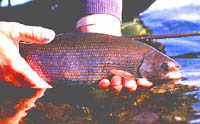 while not moving more than a few feet. It's the kind of fishing where you didn't have t
o worry about how long the fish feeding or hatch would last. You could have a shore lunch, a nap and a smoke, wade back in and start catching again. I can handle that now and then. while not moving more than a few feet. It's the kind of fishing where you didn't have t
o worry about how long the fish feeding or hatch would last. You could have a shore lunch, a nap and a smoke, wade back in and start catching again. I can handle that now and then.
Return to Index
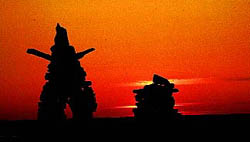
Copyright ©1998 Clive Schaupmeyer
Clive Schaupmeyer is an outdoor writer and photographer. He is the author of The Essential Guide to Fly-Fishing, a 288-page book for novice and inte
rmediate fly anglers. His photo of a boy fishing was judged the best outdoor picture of 1996 published by a member of the Outdoor Writers of Canada. He fly-fishes for trout in Alberta's foothill and mountain streams and for pike near his home in Brooks, A
lberta.
Our Man In Canada Archives
|



